Monuments and history of the Jewish community in the town and region of Końskie
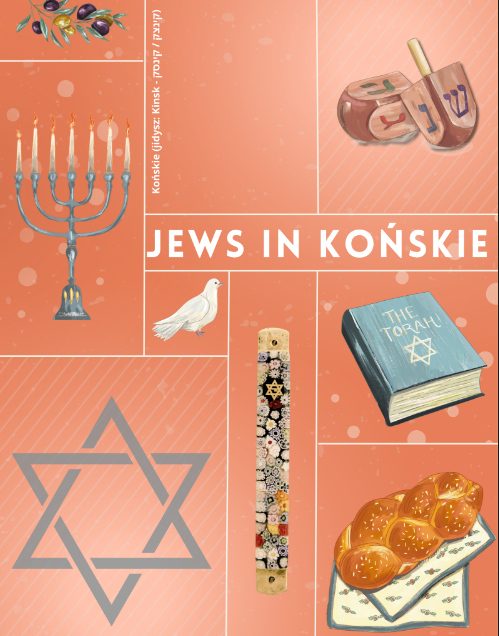 In a nutshell: The main historical facts and architectural / cultural legacy of the Jewish community in Końskie can be found in the publication entitled Jews in Końskie, developed by Rita Miernik, the author of the socio-historical project "Sad synagouges" within European Days of Jewish Culture organised by the Taube Center for Jewish Life and Learning. It is a concise informational brochure enriched by images & photos depicting the origins, life and monuments related to the Jews living in our area. This information leaflet is also available for download in the category of E-publications on the website.
In a nutshell: The main historical facts and architectural / cultural legacy of the Jewish community in Końskie can be found in the publication entitled Jews in Końskie, developed by Rita Miernik, the author of the socio-historical project "Sad synagouges" within European Days of Jewish Culture organised by the Taube Center for Jewish Life and Learning. It is a concise informational brochure enriched by images & photos depicting the origins, life and monuments related to the Jews living in our area. This information leaflet is also available for download in the category of E-publications on the website.
If you wish to explore the subject even better, please go over the sections below. There you can find out more about the history, present architectural traces of the Jews in Końskie and its surroundings. In addition, you will come across some other sources of valuable information on other Jewish landmarks in the whole province. ENJOY!
The history
The content underneath has been taken from Virtual Sztetl by Polin (the Polin Museum = Museum of the History of Polish Jews, in Warsaw). The full text is available at Virtual Sztetl by Polin.
The first record of Jews living in Końskie dates back to 1588 when King Zygmunt III Waza allowed them to buy food and other goods in the towns and villages of the Kingdom. These rights were confirmed by Władysław IV in 1635. Jews were also given permission to build houses.
In the 18th century Końskie was inhabited by 1,556 people, including 164 Jews (i.e. 10.5%). A religious community existed there most probably already in the second half of the 18th century. Some of the Jews from Końskie were engaged in trade. Among 18 Jewish merchants trading in Frankfurt in 1765, Jews from Końskie are listed.
The town was not incorporated until 1748. In 1759, there were 15 Jewish houses in Końskie. In 1775, Jews owned 207 smokes (houses), and they also obtained permission for a new synagogue.
In 1787, King Stanisław August came to Końskie - he was also welcomed by the Jews. In 1790, Jews lived in eleven out of 212 houses in the town, as well as in seven houses belonging to Catholics. The first rabbi known by name in Końskie was Jekutiel (1820), a student of the Seer from Lublin. Later, Mendel (ca. 1829) and Joszua Kinsk performed this function. In the second half of the 19th century, Mojżesz Jechiel Ha-Lewi Staszewski was the rabbi in Końskie, and in 1896 - Joaw Joszua Weingarten.
Jan Małachowski, the owner of the domains around Końskie, allowed the Jews to settle within his domain and decided on the related fees. In 1817, in the market square, the Małachowski family built stalls, called Annotarg. These trading places were mostly leased by Jews. In 1846, wooden butcheries were built at Jatkowa Street (Polish: ul. Jatkowa), which were also rented by Jews. The Jewish population lived mainly in the streets in the centre of the town, around the market square. These were: Żydowska (later Berka Joselewicza), Pocztowa, Szewska, Warszawska, Bugaj, Piotrkowska, Zatylnia and Kazanowska Streets (Polish: ul. Żydowska, Pocztowa, Szewska, Warszawska, Bugaj, Piotrkowska, Zatylnia and Kazanowska). Berka Joselewicza Street, inhabited by the Jewish proletariat, was particularly neglected.
Ironmongers from the years of 1810-1827 were: Icek Rozenfeld, Mosiek Chęciński, Dawid Manowicz, Herszla Wajsman, Szmul Przednówek, Abram Jakubowicz, Herszek Cyna, Herszla Kronenblum (later Szaja) and Rafał Rafałowicz. The craftsmen of Jewish faith also specialised in the production of carriages, carts and wagons. They sold their goods in the area, but also in Warsaw and outside the Kingdom, for example, in Ukraine. In the middle of the 19th century, Hil Wiślicki and Welwa Neufeld were famous ironmongers.
In the 1860s, Jews were granted civic rights. They lived in the vicinity of the Market Square because of the convenience of trade and craft places. These streets were: Berka Joselewicza (Jewish), Krakowska, Kazanowska, Kopce, Trzeciego Maja, Nowy Świat, Jatkowa, Przechodnia, Warszawska and Małachowskiego (Polish ul. Berka Joselewicza (Żydowska), Krakowska, Kazanowska, Kopce, Trzeciego Maja, Nowy Świat, Jatkowa, Przechodnia, Warszawska i Małachowskiego).
[...]
Annotarg in Końskie, photograph taken from konskie.org.pl.
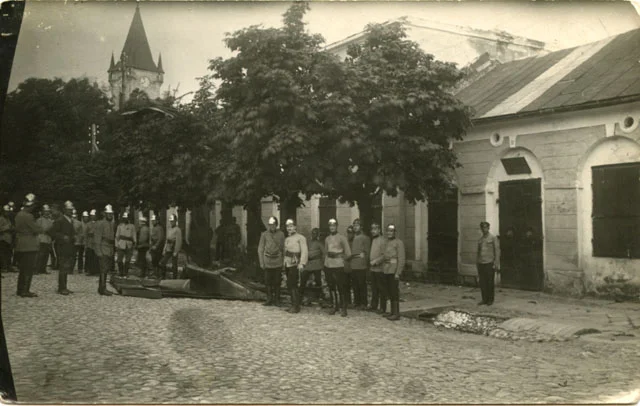
In 1933, two anonymous complaints were received by the Voivodship Office in Kielce about the way the Religious Community in Końskie functioned. One of them concerned the tenant of the bathhouse, Jakub Wigdersohn.
The Council of the Jewish Community in Końskie was elected on 8 November 1936, whereas the Board of the Council was elected on 20 June 1937. The Jewish community was dominated by non-partisans (33%). In the elections, the same result - 25% each - was achieved by Zionists and Aguda supporters. The same percentage of support was also achieved by Orthodox and Mizrachists - 8.5% each.
A practice of carrying out illegal ritual slaughter in the town was uncovered. It was carried out, among others, by ritual slaughterer Berek Strobiński. From 1922, Majer Wajngarten was the rabbi in Końskie. He was born on 4 June 1885 in Lutomiersk as the son of Shija and Sura Małka. He received his education at home. He was married and had one child. He lived at 3 Maja Street (ul. 3 Maja). The approval of Majer Wajngarten was problematic - after his father's death he served as rabbi illegally. From 1911, he assisted his father in his office as an unapproved sub-rabbi. On 16 January 1931 he passed an oral and written exam on the knowledge of the Polish language before the Examination Board in the Voivodship Office in Kielce[1.8].He was approved by the Ministry of Religious Denominations and Public Enlightenment (Polish: Ministerstwo Wyznań Religijnych i Oświecenia Publicznego) as a rabbi in Końskie on 7 June 1933. He did not engage in political or social activity, he was an orthodox[1.9].
[...]
Linocut. Końskie, synagogue built probbaly in 1684, renovated in 1905, burnt down by the German occupational authorities in September 1939 [according to the description on the linocut]. Picture taken from konskie.org.pl.
Artist-Graphic designer Bill Farran, Końskie, synagogue, print 5/25, from the series: Lost treasures: wooden synagogues of the Eastern Europe. In the collections of Krzysztof Woźniak.
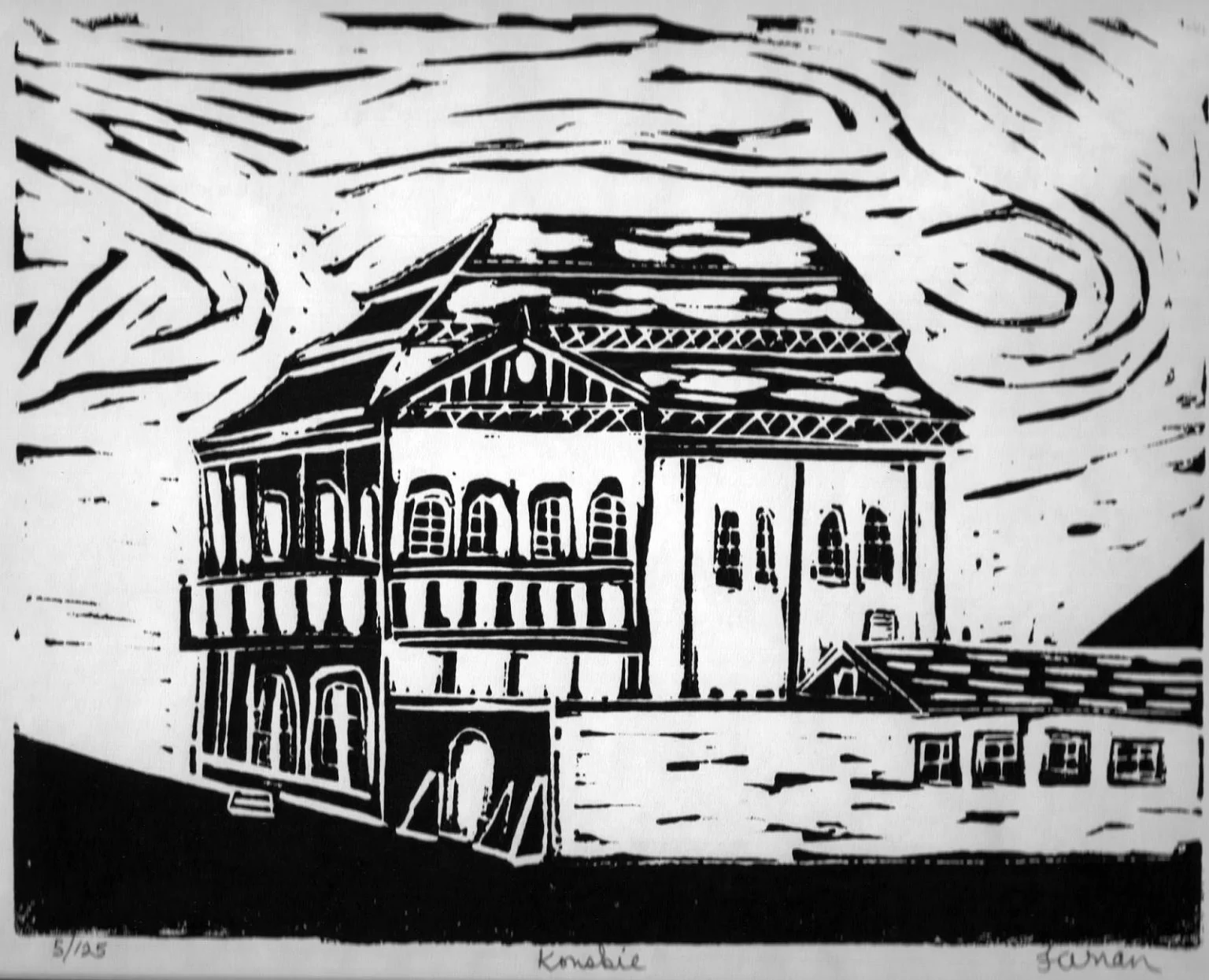
Synagogue, 1930´s. Photograph taken from the website of Świętokrzyskie Sztetl in Chmielnik.
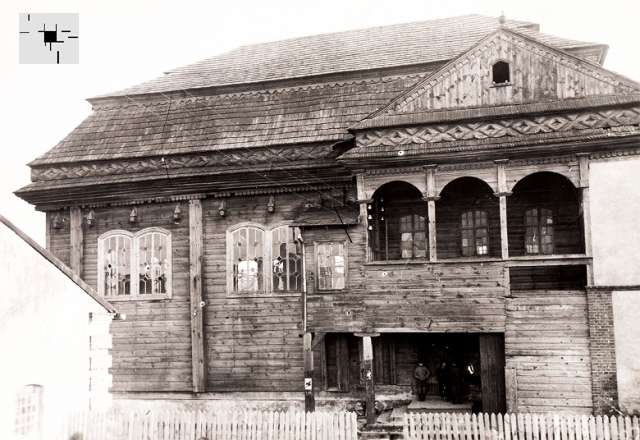
Bimah, 1930´s. Photograph taken from the website of Świętokrzyskie Sztetl in Chmielnik.
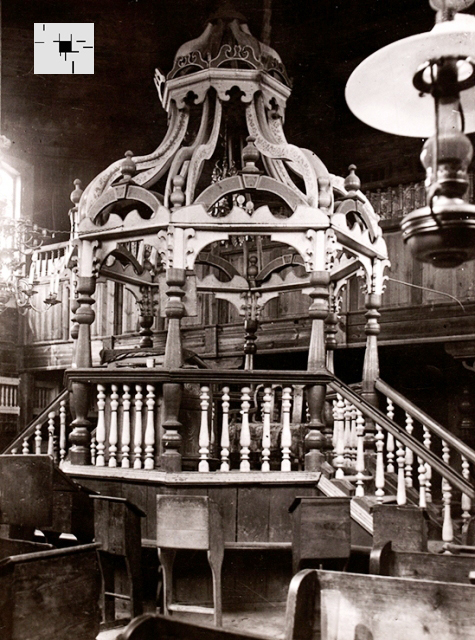
The influence of Jews on the economic development of Końskie was considerable. 26 of 34 undertakings registered in 1927 - were owned by the Jewish population. The following industrial undertakings functioned at that time:
- “Słowianin” cast iron and enamelled castings factory, was established in 1899. Its owners were Abraham Ajzenberg and Mojżesz Hochberg. The products were sent to Denmark, Finland, Bulgaria and deep into Russia;
- Foundry and mechanical works, founded in 1901. The owner was Mendel Piżyc;
- Factory for iron castings, agricultural machinery and fans, founded in 1903. The owner was Szaja Kronenblum. The factory operated throughout the interwar period and during the war. Several buildings belonging to the Kronenblums have remained to this day;
- Josek Mintz, a tradesman, in 1910 bought foundries in Krasna and Nieborów near Stąporków. “Neptun” foundry was established in 1913. The owner did not enjoy a good reputation among workers. Mintz used underage workers, dismissed those who were inconvenient and took them back under worse conditions. Some people were dismissed before they had worked a full year and lost their rights to leave and unemployment benefits. There were frequent strikes in the factory. In 1935, about 60 Jews were employed in the “Neptun” J. Mintz factory in Końskie[1.10];
- soap factory owned by Lejbuś Młynek[1.11];
- brass foundry of Kałma Rozencwajg and Judka Tin and Wolf Borensztajn;
- Z. Grundman and W. Szlachter’s (Szlamter) sweet vodka factory[1.12]. In 1920 the factory employed 13 workers;
- Berek Rabinowicz's oil mill[1.13].
Mojżesz Hochberg, who came from Bar, made a significant contribution to the development of the metal industry in the Kielce region. He came to Poland at the end of the 19th century and took a liking to the town of Końskie. In 1899, he set up an iron casting factory called “Słowianin”, focused mainly on exporting products to Russia. The factory produced iron castings used for sewage systems, parts for furnaces, ironing machines, raw and enamelled pots. In its heyday the plant employed about 1,000 workers (in 1913 - 850 labourers). In the first years of the Polish state, the company was experiencing problems, which was evident in the employment figures. In 1920, the factory provided work for only 300 workers. In 1929, the enterprise was transformed into a company. The management board consisted of Mojżesz Hochberg and Jan Marciniak. Szymon Weinberg, Wacław Styburski and Zdzisław Miedziejewski became directors. The company's capital amounted to 650,000 zlotys.
Mojżesz Hochberg was a social activist. Thanks to his initiative, a house for Jewish orphans was established in Końskie. Hochberg sat in the assembly of the District of Końskie and was a councillor of the Chamber of Industry and Commerce in Sosnowiec. However, he also committed large-scale forgery. He signed products manufactured in his plant with the monogram of “Herzfeld et Victorius” company from Grudziądz. The crime was discovered and the owner of "Słowianin" was fined heavily, which led to financial problems of the company. Mojżesz Hochberg stepped down as the owner of the factory, he took the position of its manager. Jews predominated among the traders in Końskie in the interwar period. In 1919, 20 people rented stalls in the Market Square, 12 of them were Jews. In 1925, 12 people, including eight Jews, took part in a tender for the lease of town crates. In 1934, 20 out of 34 stalls in Annotarg were rented by Jews.
In 1927, Abram Gancwajch, the owner of a printing house, published “Konsker Cajtung” (Polish: “Gazeta Konecka”). This was a weekly published in Yiddish. The Germans marched into Końskie in September 1939. The Germans started to repress the Jewish population, among others by taking over their businesses. They also levied contributions, e.g. by 1 December 1939, the Jews of Konin paid 150,000 zlotys: “to compensate for the warlike attitude caused by the world Jewry”[1.14]. On the first day after the occupation of the town, in the evening hours, they burned down the synagogue. Soon a Judenrat was formed. Józef Rosen (a pre-war clerk) was appointed chairman; Alter Stark and Jechezkiel Gottlieb, among others, were members.
The first mass execution of Jews took place on 12 October 1939 when 22 people were killed. Initially, chosen Jews from Końskie were forced to dig graves in the square next to the church for German soldiers killed in the battle of Kazanów (7 September 1939). After the work was completed, the Germans started a shooting chaotically towards fleeing Jews.
The pre-war office building of the Hochberg Iron Foundry housed the headquarters of the German police authorities during World War II. It was the seat of the criminal police, and later the seat of the Gestapo[1.15] There was a jail in the basement of that building.
In February and March 1941, the first transports of Jews from the Polish territories incorporated into the Reich arrived in the town. In 1941, a ghetto was established on Strażacka, Trzeciego Maja, Warszawska Street from number 25 upwards (Polish: ul. Strażacka, Trzeciego Maja, Warszawska), and Bóżnicza Street (Polish: ul. Bóżnicza). Driesen was then the occupational head of the town. Jews were transported to Końskie from various places, such as Łódź, Sosnowiec, Kielce, Łopuszno, Wieloń, Gniezno, Aleksandrów, Przedborze, Gowarczów, Opoczno, Kraków, Skarżysko, Toruń, Kalisz, Żyrardów.
In November 1942, the ghetto was liquidated and its inhabitants transported mainly to the Treblinka extermination camp. In total, about 7,000 people died after the liquidation of the closed quarter. The few Jews who survived the liquidation of the ghetto were transported to the Szydłowiec ghetto in January 1943. More about the ghetto in Końskie.
Końskie, ghetto, ul. Rynek 2. Photograph from konskie.org.pl, made available by Mateusz Partyka
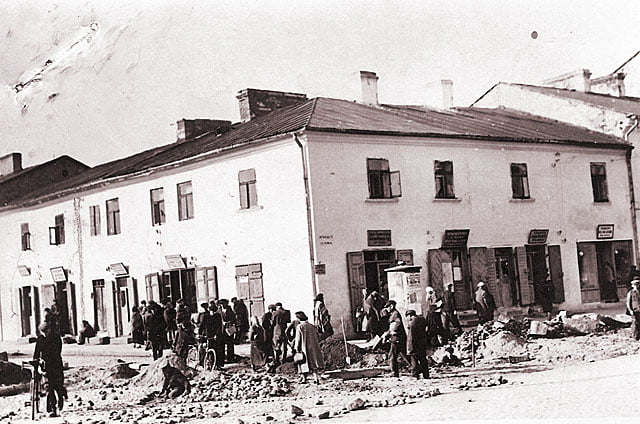
Moreover, in Końskie there used to be a Jewish cemetery, established probably in the XVII c. In the aftermath of the WWII it ceased to exit (it was destroyed by the Nazi Germans). More about the cemetery.
### Information in English about the Jewish community in the town and region of Końskie can also be found on the official website of Świętokrzyskie Sztetl in Chmielnik (the education and museum centre in Chmielnik).
The remnants of the Jewish community in the town & region of Końskie:
*** Sukkahs in Końskie
In the town architecture one can still observe "sukkahs". [A sukkah or succah (/ˈsʊkə/; Hebrew: סוכה [suˈka]; plural, סוכות [suˈkot] sukkot or sukkos or sukkoth, often translated as "booth") is a temporary hut constructed for use during the week-long Jewish festival of Sukkot. It is topped with branches and often well decorated with autumnal, harvest or Judaic themes. / definiton taken from Wikipedia.
Końskie ul. Marszałka Piłsudskiego, photograph by Krzysztof Woźniak, taken from konskie.org.pl

Końskie ul. Wjazdowa, photograph by Krzysztof Woźniak, taken from konskie.org.pl
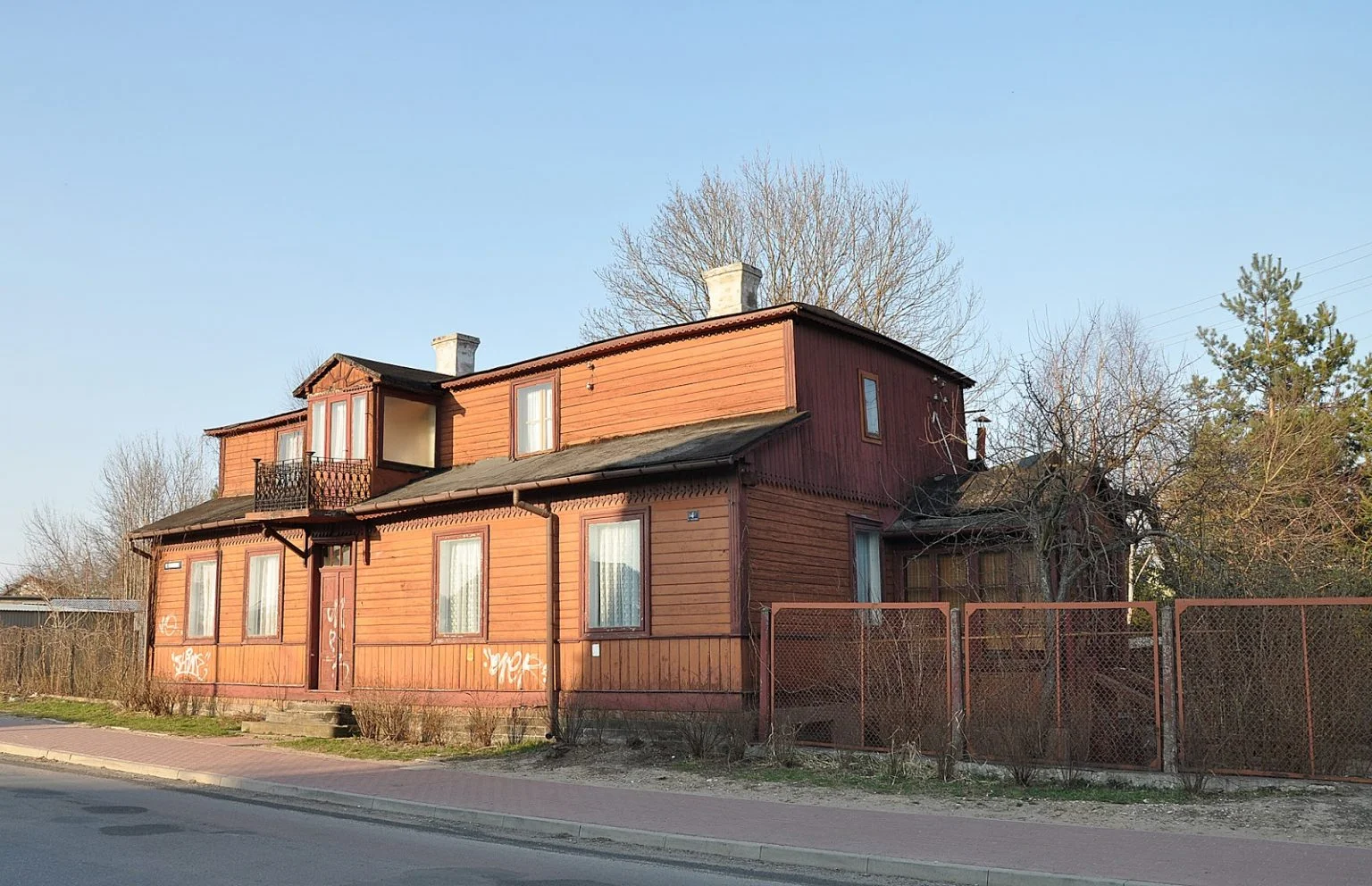
Końskie ul. Strażacka, photograph by Krzysztof Woźniak, taken from konskie.org.pl
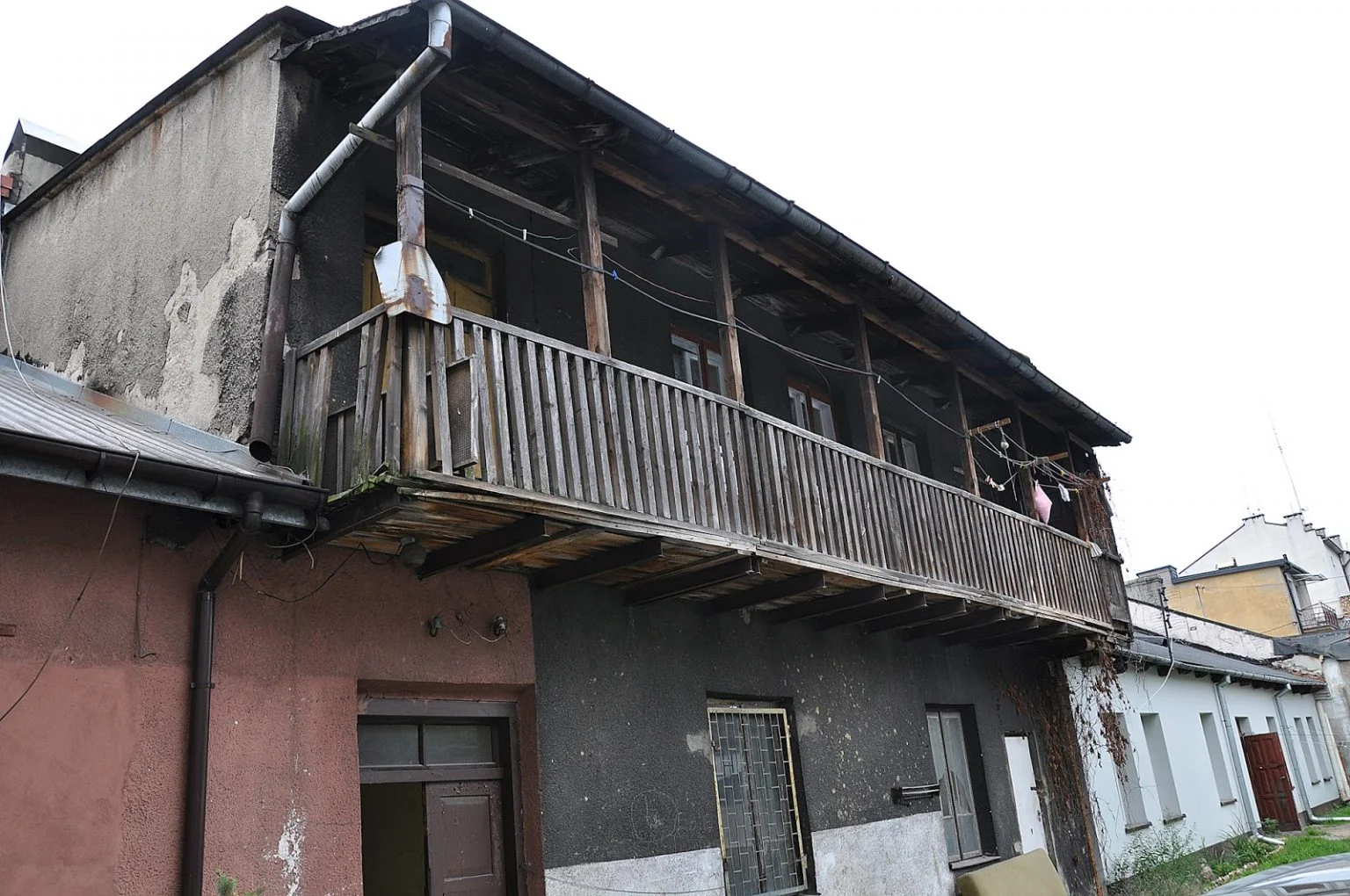
*** Jewish cemetery in Radoszyce
The cemetary of the former Jewish commune in Radoszyce is situated about 1,5 km north-west of the centre of the town. It is located on a hill near the village of Wisy, by the road to the village of Lipa. [1]
The hill, the cemetery lies on, is called Królowa Góra (in English „The King’s Mountain”). The Jews call it Beit Kwarot – the House of Graves, Beit Chaim – the House of Life or Be-it Olam – the House of Eternity. This area of the burial of the deceased was destroyed during the German occupation in the period of 1939-1945 but for the Hebrew people it is a sacred place. This piece of land shrouds the remains of the ones having died over centuries and also the ones having been murdered by the Germans in the WWII. Great respect for the deceased is a sign of the immense piety of the Jews and their belief in eternal life. Every year Radoszyce is visited by tour groups from around the world, particularly by the Orthodox Jews, so that they could pray at kirkut where there is an ohel of the tzadik Isachar Dow Ber Radoszicer (1765-1843) and the rabbi and tzadik Izrael Finkler who died on 1.08.1937. [2]
The cemetery was established before 1789. In 1843 in here was buried the tzadik Isachar Dow Ber Baron – the founder of the chasid dynasty in Radoszyce. In 1905 the area was enlarged. In the interwar period the place was enclosed by a stone fence.
In the WWII the cemetery destruction began. The gravestones were used by the Germans and local inhabitants as building material and grinding wheels. Nearly all the overground elements of the cemetery were obliterated.
On 22 June 1964 the Minister of the Urban Engineering - as a result of the act adopted by the Assmebly Presidium of the National Council in Radoszyce from 6 August 1957 – issued an edict to close down the cemetery.
In 1987 the facility was „devastated, completely covered by the forest”, within its borders there were single fragments of matzevahs visible, along with graves digged out, scattered bones and the relic of the stone fence. At that time the user of the cemetery was the forest district of Ruda Maleniecka.
Probably at the turn of the 80 and 90s the ohel of the tzadik Isachar Dow Ber Baron was rebuilt. In the years 2010-2011 the Foundation for the Preservation of Jewish Heritage in cooperation with the tzadik community had the cemetery fenced in and the access road to it built. In 2017 there was a new ohel erected whose architecture refers to the notion of the Solomon’s temple in Jerusalem. The rectangular, massive structure got crowned with battlements, present in the old-oriental architecture and in contemporary models of the Jerusalem Temple. The building elevation was covered in stone of the Jerusalem colour. Within the area of the cemetery there are several dozen gravestones, discovered in the recent years in Radoszyce and neighbouring villages.
The owner of the cemetery is the Foundation for the Preservation of Jewish Heritage. The facility is listed in the register of the immobile monuments of the Świętokrzyskie (Holy Cross) province (no. A.938 from 16.08.2018). The keys to the gate and the ohel are made available by the cemetery supervisor (tel. +48 607 983 265).[3]
[1]http://cmentarze-zydowskie.pl/radoszyce.htm
[2]https://konskie.org.pl/2014/10/05/kirkut-w-radoszycach/
[3]http://cmentarze-zydowskie.pl/radoszyce.htm
Information board at the gate to the Jewish cemetery in Radoszyce.
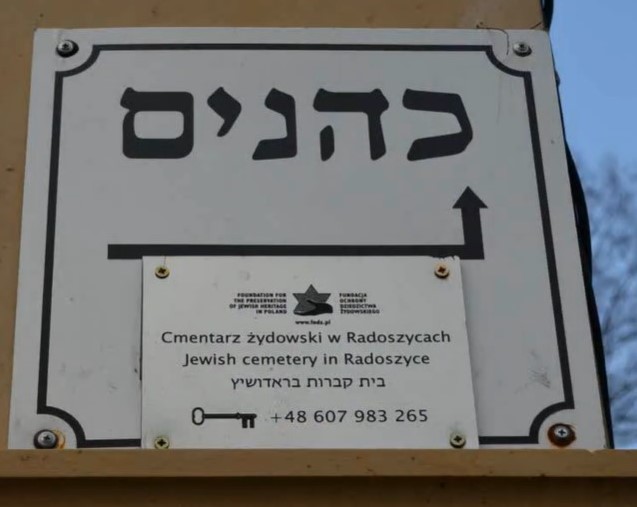
The current state of the cemetery near Radoszyce can be seen in the video by Ryszard Bielawski [Born on 14 September in Lida in Belarus. A graduate from the University of Warsaw, holder of a Master’s degree in philosophy and a PhD in zoological sciences. In the period of 1948-1978 Ryszard Bielawski worked at the Institute of Zoology of the Polish Academy of Sciences and as en entomologist participated in research expeditions to China, India, Korea and Mongolia, studying the local fauna.].
Below: the author's footage entitled "Following the traces of the past. The Jewish cemetery. Radoszyce."
Some other landmarks commemorating the Jewish community in the Świętokrzyskie (Holy Cross) province:
Information in 
- Świętokrzyskie Sztetl in Chmielnik
- Synagogue in Chęciny
- Town of Pińczów
- Town of Sandomierz
- Town of Szydłów
***Historical information on synagogues in Poland (including the Świętokrzyskie [Holy Cross] province) & images can also be found on the official website of the Hebrew University of Jerusalem in the section of the Center for Jewish Art in the catalogue of Wall Paintings in the Central and East-European synagogues in the folder of the country of Poland.
One needs to type in in the search field in the top left-hand corner e.g. "Chmielnik", "Checiny", "Pinczow" or "Sandomierz" (using Latin letters).
developed by Anna Kania, the employee of the Tourist Information Centre in Końskie




